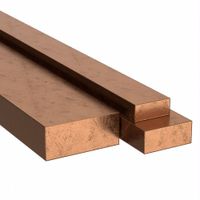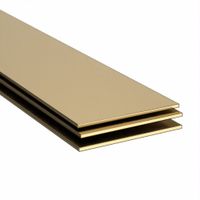Call +(254) 703 030 000 / 751 483 999 / 721 704 777
- Home
- Raw Materials
- Metals
- Bronze
.....Read More
Frequently Asked Questions
What is bronze made of?
Bronze is an alloy primarily composed of copper and tin. Typically, the composition of bronze is about 88% copper and 12% tin, although these proportions can vary depending on the specific type of bronze and its intended use. The addition of tin to copper enhances the metal's hardness and strength, making it more durable than pure copper.
In addition to copper and tin, bronze may also contain small amounts of other elements such as aluminum, manganese, nickel, or zinc, which can be added to produce specific properties or to improve the alloy's performance in certain applications. For example, aluminum bronze contains aluminum, which increases its corrosion resistance and strength, making it suitable for marine environments.
Bronze is known for its distinctive reddish-brown color, which can develop a greenish patina over time due to oxidation. This patina is often considered aesthetically pleasing and can also provide a protective layer against further corrosion.
The alloy has been used for thousands of years, dating back to the Bronze Age, when it was utilized for tools, weapons, and various artifacts due to its superior properties compared to stone and pure copper. Today, bronze is still widely used in applications such as sculpture, musical instruments, bearings, and coins, owing to its workability, resistance to corrosion, and attractive appearance.
What are the properties of bronze?
Bronze is an alloy primarily composed of copper and tin, typically in proportions of about 88% copper and 12% tin, though these ratios can vary. It is known for its distinct reddish-brown color and several key properties:
1. **Durability**: Bronze is highly durable and resistant to wear and corrosion, making it ideal for use in tools, weapons, and sculptures.
2. **Hardness**: It is harder than pure copper due to the addition of tin, which enhances its strength and makes it suitable for applications requiring a tough material.
3. **Malleability and Ductility**: Bronze can be easily shaped and formed into various designs without breaking, allowing for intricate artistic and industrial applications.
4. **Low Friction**: It has a low coefficient of friction against other metals, which makes it useful in applications like bearings and bushings.
5. **Thermal and Electrical Conductivity**: While not as conductive as pure copper, bronze still maintains good thermal and electrical conductivity, suitable for certain electrical applications.
6. **Melting Point**: Bronze has a relatively low melting point compared to steel, which facilitates casting and molding processes.
7. **Acoustic Properties**: It is often used in musical instruments, such as bells and cymbals, due to its resonant sound qualities.
8. **Antimicrobial Properties**: Like copper, bronze has natural antimicrobial properties, which can be beneficial in reducing the spread of germs.
9. **Aesthetic Appeal**: Its rich color and ability to develop a patina over time make it desirable for decorative purposes.
10. **Non-Sparking**: Bronze does not produce sparks when struck, making it safe for use in explosive environments.
These properties make bronze a versatile material used in a wide range of applications, from art and architecture to industrial machinery and marine hardware.
What are common uses of bronze?
Bronze, an alloy primarily composed of copper and tin, is renowned for its durability, corrosion resistance, and aesthetic appeal. Its common uses span various fields:
1. **Sculpture and Art**: Bronze is a favored material for sculptures and statues due to its ability to capture fine details and its appealing patina over time. Artists have used it for centuries to create enduring works.
2. **Musical Instruments**: The alloy is used in the production of musical instruments, such as cymbals, bells, and gongs, because of its excellent acoustic properties.
3. **Medals and Trophies**: Bronze is traditionally used for third-place medals in competitions and various trophies, symbolizing achievement and excellence.
4. **Architectural Elements**: Its resistance to weathering makes bronze ideal for architectural applications, including doors, railings, and decorative elements.
5. **Marine Hardware**: Due to its resistance to corrosion, especially in saltwater environments, bronze is used for ship fittings, propellers, and underwater bearings.
6. **Industrial Applications**: Bronze is employed in the manufacturing of bushings, bearings, and gears due to its low friction and wear resistance.
7. **Coins**: Historically, bronze has been used in minting coins, valued for its durability and ease of casting.
8. **Tools and Weapons**: In ancient times, bronze was used to make tools, weapons, and armor, marking a significant technological advancement during the Bronze Age.
9. **Electrical Connectors**: Its good conductivity and resistance to sparking make bronze suitable for electrical connectors and components.
10. **Decorative Items**: Bronze is used in crafting jewelry, vases, and other decorative objects, appreciated for its warm color and ability to develop a unique patina.
These diverse applications highlight bronze's versatility and enduring importance across various industries and cultures.
How is bronze different from brass?
Bronze and brass are both copper alloys, but they differ primarily in their composition and properties. Bronze is an alloy of copper and tin, typically containing about 12% tin, although other elements such as aluminum, manganese, nickel, or zinc may also be added to enhance its properties. Brass, on the other hand, is an alloy of copper and zinc, with the zinc content usually ranging from 5% to 45%.
The differences in composition lead to distinct characteristics. Bronze is generally harder and more brittle than brass, making it suitable for applications requiring durability and wear resistance, such as in the production of bearings, bushings, and sculptures. It also has a lower melting point and is more resistant to corrosion, especially from saltwater, which makes it ideal for marine applications.
Brass, with its higher malleability and ductility, is easier to work with and is often used in applications where a combination of strength and formability is needed, such as in musical instruments, plumbing fittings, and decorative items. Its bright gold-like appearance also makes it popular for ornamental purposes.
In terms of color, bronze typically has a duller, darker brown hue, while brass exhibits a brighter, more yellowish tone. The acoustic properties also differ; bronze produces a more resonant sound, which is why it is often used in bells and cymbals.
Overall, the choice between bronze and brass depends on the specific requirements of the application, including factors like strength, corrosion resistance, workability, and aesthetic appeal.
What are the advantages of using bronze?
Bronze, an alloy primarily composed of copper and tin, offers several advantages:
1. **Durability**: Bronze is highly durable and resistant to wear and corrosion, making it ideal for applications exposed to harsh environments, such as marine hardware and outdoor sculptures.
2. **Malleability**: It is more malleable than pure copper, allowing for easier casting and shaping into complex forms, which is beneficial in art and manufacturing.
3. **Low Friction**: Bronze has a low coefficient of friction against other metals, making it suitable for bearings, bushings, and other components where metal-to-metal contact occurs.
4. **Antimicrobial Properties**: Like copper, bronze possesses antimicrobial properties, which can be advantageous in applications where hygiene is critical, such as in medical equipment and food processing.
5. **Aesthetic Appeal**: The alloy has a distinctive, attractive appearance that can develop a desirable patina over time, enhancing its use in decorative arts and architecture.
6. **Electrical Conductivity**: While not as conductive as pure copper, bronze still maintains good electrical conductivity, making it useful in electrical connectors and components.
7. **Thermal Conductivity**: Bronze's ability to conduct heat efficiently makes it suitable for applications like heat exchangers and cookware.
8. **Non-Sparking**: Bronze does not produce sparks when struck, which is crucial in environments with flammable gases or vapors, such as in tools used in mining and oil industries.
9. **Strength**: The alloy is stronger than pure copper, providing enhanced mechanical properties for structural applications.
10. **Versatility**: Bronze can be alloyed with other elements to enhance specific properties, allowing for tailored solutions in various industrial and artistic applications.
How is bronze manufactured into different shapes?
Bronze is manufactured into different shapes through several processes, primarily casting, forging, and machining.
1. **Casting**: This is the most common method for shaping bronze. It involves melting the bronze alloy, which typically consists of copper and tin, and pouring it into a mold. The mold is usually made of sand, plaster, or metal and is designed to the desired shape. Once the molten bronze cools and solidifies, the mold is removed, revealing the cast shape. Techniques like sand casting, investment casting, and centrifugal casting are often used, each offering different levels of detail and finish.
2. **Forging**: In this process, bronze is heated until it becomes malleable but not molten. It is then hammered or pressed into the desired shape. Forging enhances the strength and durability of the bronze by aligning its internal grain structure. This method is typically used for creating tools, weapons, and other items that require enhanced mechanical properties.
3. **Machining**: After casting or forging, bronze objects may undergo machining to achieve precise dimensions and surface finishes. This involves cutting, drilling, or milling the bronze using various tools and machines. Machining is essential for creating intricate details and ensuring that parts fit together correctly in assemblies.
4. **Cold Working**: This involves shaping bronze at room temperature through processes like rolling, bending, or drawing. Cold working increases the hardness and strength of the bronze due to work hardening.
5. **Finishing**: After shaping, bronze items often undergo finishing processes such as polishing, patination, or coating to enhance their appearance and protect against corrosion.
These methods allow bronze to be manufactured into a wide range of shapes and sizes, suitable for applications in art, industry, and everyday objects.
What are the different grades of bronze?
Bronze is an alloy primarily consisting of copper, with tin as the main additive, but it can also include other elements. The different grades of bronze are categorized based on their composition and properties:
1. **Phosphor Bronze**: Contains 0.5-1% tin and a small amount of phosphorus. It is known for its toughness, low friction, and fine grain. Commonly used in springs, bolts, and bearings.
2. **Aluminum Bronze**: Comprises 6-12% aluminum and small amounts of iron and nickel. It offers high strength, corrosion resistance, and is used in marine hardware and pumps.
3. **Silicon Bronze**: Contains about 96% copper, 3% silicon, and 1% manganese. It is known for its easy casting, corrosion resistance, and is used in architectural applications and sculptures.
4. **Manganese Bronze**: A high-strength alloy with up to 3% manganese, along with zinc and aluminum. It is used in heavy-duty applications like propellers and gears.
5. **Leaded Bronze**: Contains lead, which improves machinability. It is used in bushings and bearings due to its good wear resistance.
6. **Nickel Bronze**: Contains nickel, which enhances strength and corrosion resistance. It is used in applications requiring high durability.
7. **Bismuth Bronze**: An eco-friendly alternative to leaded bronze, using bismuth for similar properties without the toxicity of lead.
Each grade of bronze is tailored for specific applications, balancing factors like strength, corrosion resistance, machinability, and cost.



